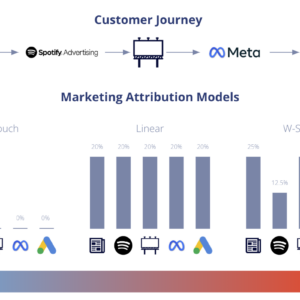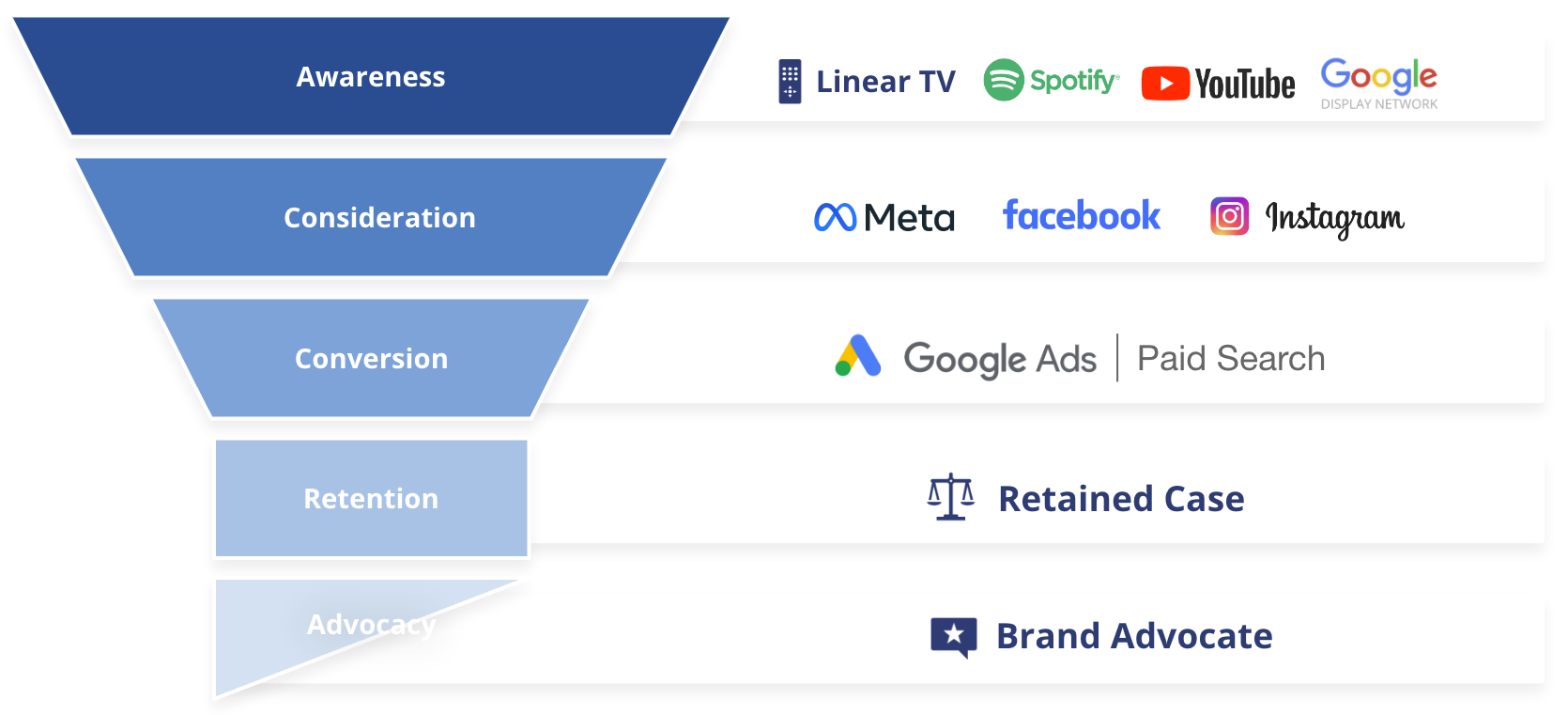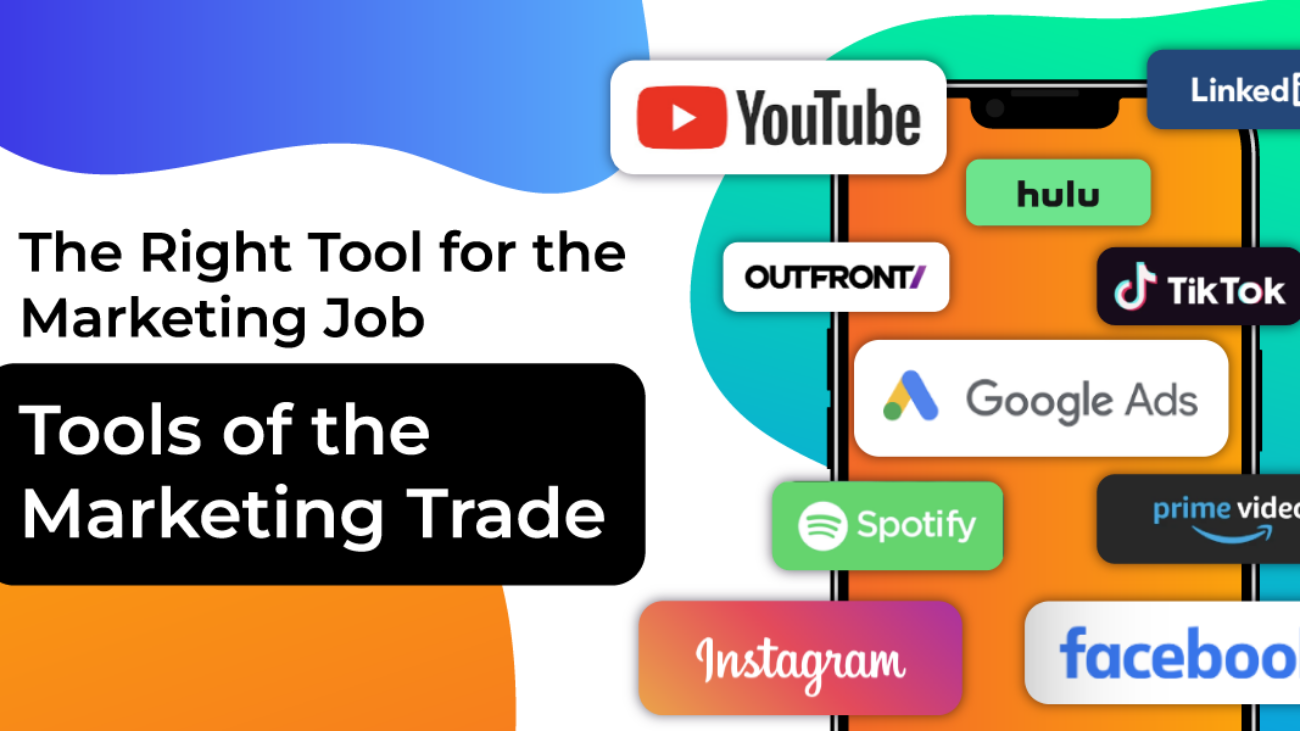The Importance of Pairing the Right Channels With Each Stage of the Marketing Funnel
Tools of the Marketing Trade
Marketing attribution models
Marketing attribution models are “framework[s] for analyzing which touchpoints, or marketing channels, receive credit for a conversion” (Foy, AgencyAnalytics), and there is an overwhelming number of them for digital marketers to choose from. From the first-touch model (one of the simplest) to the W-shaped model (one of the most complex), each model has its pros and cons, and which one is the right choice depends on your industry, your customer journey map, and the marketing channels you utilize.

For example, a small-town, brick-and-mortar florist running online radio and paid search ads exclusively isn’t going to employ a complex attribution model; they’re most likely going to use the last-touch attribution model and simply ask their customers what brought them in. Was it an online radio ad, a paid search ad, a referral, or was it simply driving/walking by their shop?
On the other hand, a multistate law firm running online radio, billboard, traditional radio, connected TV (CTV), linear TV, paid search, display, and paid social ads makes use of too many marketing channels to utilize a simple marketing attribution model. Connected TV, paid search, display, and paid social ad platforms (e.g., Amazon Ads, Google Ads, AdRoll, and Meta Ads Manager) all have their own way of tracking conversions that result from their ads but—more often than not—are very tough to integrate together into a single attribution model.
Think critically about your customer journey map
Your customer journey map “is not something to assume or predict based on your internal perspective. A customer journey is very specific to the physical experiences your customers have” (Agius, HubSpot). It can be deceivingly easy to think—because you see bits and pieces of it in your work—that you know what your customer journey map looks like, and you might! But often, mapping your customer journey (the complete experience that a customer has with your business) is more difficult than you’d think.
Think of all the ways you found the brands that you are now loyal to. Maybe you saw one of their ads on social media, one of their billboards on your way to work, or one of their products in a movie or TV show. Maybe a friend recommended them to you. Or maybe you even dug through three pages of Google search results before you finally found that perfect t-shirt, laptop, or car. The vast majority of your customers’ journeys—when you are successful in converting them—will probably end in roughly the same destination. The places they begin, however, are numerous and diverse.
When mapping your customer journey (an important step in choosing the right marketing attribution model for your business), think critically and creatively about your brand’s online, physical, and even intangible presence. Word-of-mouth marketing is exceptionally impactful in service industries, so it’s very possible that the last customer your lead intake team spoke to had never seen (or at least noticed) anything actually created by your business. As a result, when analyzing conversions that came in through paid search (or any other source), think about where else those converting customers could have been before they clicked on your paid search ad.
The power of brand awareness & recognition
Don’t get us wrong, paid search is an indispensable part of any digital marketing strategy; without it, there is not much of a point in engaging in digital marketing at all. Nonetheless, if you wish to build brand awareness and increase brand recognition, paid search alone isn’t going to cut it (even if the vast majority of your conversions are currently coming in through it).
Brand Awareness
Brand awareness “describes how familiar (aware) consumers are with a brand or its products” (Bynder). In other words, you build brand awareness the more consumers become aware of your brand’s existence.
Example: Alyssa mentions to her friend Carmen that she wants to get in touch with a personal injury attorney regarding a serious injury she recently sustained in a car accident. Carmen tells her that she knows of a local personal injury law firm, Rogers & Hoff, P.C. (R&H), and that she remembers from a billboard ad of the firm’s that it specializes in car accidents. In doing so, Carmen demonstrates brand awareness of R&H.
Brand Recognition
Brand recognition, on the other hand, “refers to the ability of consumers to recognize and identify a specific brand” (Bynder). To rephrase, you increase brand recognition the more consumers recognize the visual and/or auditory traits of your brand’s identity.
Example: While driving down the highway, Ajay glances at a billboard and sees a photo of two men in business suits on a black, white, and orange background. Because he’s seen a handful of R&H ads before, Ajay is familiar with the colors and faces of the law firm’s brand, so he knows without even reading the ad copy on the billboard that the ad is one of the firm’s. In doing so, Ajay demonstrates brand recognition of R&H.
Building brand awareness and increasing brand recognition are crucial to getting consumers to think about giving you their business during the consideration stage of the customer journey, or when “the potential customer is a little familiar with your product or service, and is evaluating [their] problem,” and “your goal is to show them all the ways their problem can be solved, how beneficial it will be for them and how you and your product can help” (Shuteyev, Snov.io).
In short, during the consideration stage, potential customers are assessing their options, and it’s your job as a marketer to ensure that your brand is not only among those options but among the best of those options.
Choosing the Right Tools
If all you have is a hammer, everything looks like a nail
Pairing the right channel(s) with each stage of your customer journey and marketing funnel is a bit like pairing the right wines with each course of a full-course meal; just because a channel/wine is generally good, doesn’t mean that it works well with the stage/course with which you’ve paired it. In fact, it might work so poorly with the stage/course that it defeats the purpose of the stage/ruins the taste of the course.
The law of the instrument, aka Maslow’s hammer (after American psychologist Abraham Maslow), is a type of cognitive bias involving over-reliance on a familiar tool.
“I suppose it is tempting,” Maslow wrote in his The Psychology of Science: A Reconnaissance in 1966, “if the only tool you have is a hammer, to treat everything as if it were a nail.”
If the only marketing channel your business has ever deployed is paid search, then you might think that you can use paid search to accomplish any marketing goal your business sets for itself. But, although paid search is an absolutely essential part of any law firm marketing strategy aimed at driving conversions, it is not the be-all and end-all of marketing (or even digital marketing)—no one channel is.
In order to avoid falling into the trap of Maslow’s hammer, it’s important to familiarize yourself with a wide variety of marketing channels, tactics, attribution models, and methods of data analysis. The more tools you have in your marketing tool belt (even if you do not yet plan to utilize them), the more prepared you will be to tackle any marketing challenge that comes your way. Take the time to learn about different channels and to think about where and how well they might fit into your customer journey map and marketing funnel. The following diagram shows which stage of the marketing funnel some of the most popular marketing channels pair best with:

Choosing your marketing attribution model
When it comes time to actually choose the marketing attribution model by which your organization will attribute credit to its various marketing channels, think back to your customer journey map (which you should have a firm grasp on before proceeding) and look forward to your marketing goals. If, like some of Élan’s clients, your business is a personal injury law firm, chances are you’ll be employing a first-touch, last-touch, or linear attribution model. (A linear attribution model splits conversion credit equally among all known brand touchpoints.) This is especially true if the conversion event you’re attributing credit for is a lower-funnel conversion event like a customer signing on to work with your firm on their case.
Which marketing attribution models are even available to you depend on your organization’s conversion tracking capabilities. If your business engages only in traditional (as opposed to digital) marketing, then you’ll be lucky to get away with employing a multi-touch attribution model like linear attribution, let alone time-decay attribution or position-based attribution. It is important to note, however, that this is not necessarily a bad thing. As the old saying goes, perfect is the enemy of good. An elementary model like first- or last-touch attribution can be more than sufficient for the purposes of a law firm or other business utilizing only traditional marketing channels.
On the other hand, if your business engages heavily in digital marketing and has a website on which it can place a web analytics tag such as the Google tag, then you’ll be able to employ a much more sophisticated attribution model. While complex models like W-shaped attribution are often overkill for non-ecommerce businesses, middle-of-the-road models (like time-decay attribution and position-based—also known as U-shaped—attribution) can be very practical for law firms and other such businesses when they’re utilizing more than a couple of digital marketing channels.
Need help navigating your customer journey?
Élan’s team of marketing pros includes experts in paid search, display, paid social, traditional marketing, and more. We help businesses in the legal and healthcare industries optimize their marketing budgets by putting each dollar to its best use, and we would love to do the same for your business.
Contact us today to learn how a free marketing audit by Élan could help your business take its digital and traditional marketing to the next level.

